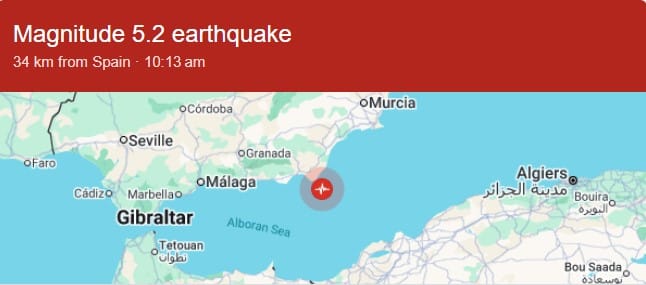
To comprehend why Spain experiences earthquakes, one must look beneath the surface. The Iberian Peninsula, where Spain is located, sits at a complex geological crossroads. Here, the Eurasian and African tectonic plates slowly push against each other. This immense pressure builds up over time along various fault lines. When this pressure suddenly releases, it causes an earthquake.
The main area of concern is the Azores-Gibraltar Fault Zone. This is a major boundary between the plates. It stretches from the Azores islands in the Atlantic, through the Strait of Gibraltar, and into the Alboran Sea, which is the western part of the Mediterranean. This zone has been responsible for some of the most significant earthquakes to affect Spain historically. A notable example is the devastating 1755 Lisbon earthquake, which had a profound impact even on southern Spain.
Within Spain, some regions are especially prone to earthquakes. The southern and southeastern parts of the country, particularly Andalusia (provinces like Granada, Málaga, and Almería) and the Region of Murcia, experience the most frequent tremors. This is because of active fault systems there, such as the Betic-Rif Fault System. These are a direct result of the African and Eurasian plates interacting. The Pyrenees mountains in the north, on the border with France, also see earthquake activity. These quakes are typically smaller and are linked to the ongoing uplift of the mountains.
Most earthquakes in Spain are small. Many are too faint for people to feel, or they feel like only a slight tremor. However, the possibility of moderate to strong quakes remains. This is clear from historical events and current earthquake monitoring. The country’s seismic network, managed by the National Geographic Institute (IGN), constantly tracks ground movement. This provides vital information for quick responses and scientific study.
The Latest Tremors: A Recent Overview of Seismic Activity
Recent days have seen a noticeable increase in earthquake activity across parts of Spain. This has been particularly concentrated in the **Granada province of Andalusia. On July 12, 2025, a magnitude 4.7 earthquake struck near Santa Fe, Granada, at approximately 10:23 PM local time. The earthquake was shallow, at a depth of about 5 kilometers.
This tremor was widely felt across a broad area, including much of Andalusia, reaching cities like Málaga and Córdoba. Residents in central Spain also reported feeling the shaking. While initial reports confirmed no major structural damage or serious injuries, the event caused widespread alarm. Thousands of residents quickly moved out of buildings as a safety precaution.
Emergency services were immediately activated to check the situation. Local authorities urged people to stay calm while also advising them to be ready for potential aftershocks. This main earthquake was followed by dozens of smaller aftershocks. Most were below magnitude 3.0, but some reached up to magnitude 3.8. These smaller tremors were also felt by residents and added to public concern.
Seismologists from the National Geographic Institute (IGN) have been actively monitoring these events. They confirmed that this recent series of quakes is typical for the known seismic patterns of the **Betic Fault System in the region. They stress that most of these events are normal for the area. They are a sign of active, though usually slow, movement of the Earth’s plates. However, they continue to examine the data for any signs of larger, more significant shifts in seismic activity.
Recent Significant Earthquakes in Spain (July 2025)
| Date | Magnitude | Location | Depth (km) | Impact (Reported) |
|---|---|---|---|---|
| July 12, 2025 | 4.7 | Santa Fe, Granada | 5 | Widespread alarm, no major damage reported, aftershocks felt |
| July 13, 2025 | 3.8 | Pinos Puente, Granada | 7 | Felt by many residents, minor public concern |
| July 10, 2025 | 3.2 | Velez-Malaga, Malaga | 12 | Lightly felt by some residents |
Historical Context: Spain’s Major Earthquakes
While often known for gentler tremors, Spain has a history of powerful earthquakes that teach important lessons in being prepared. The most famous is the 1755 Lisbon earthquake. Although its center was off the coast of Portugal, it caused a huge tsunami. This wave devastated parts of the Spanish Atlantic coast and severely damaged cities like Cádiz. Its sheer size and far-reaching effects highlight how connected seismic activity is in this region.
More recently, the 1884 Andalusia earthquake, which happened near Arenas del Rey in Granada, was one of the most destructive in Spain’s memory. It caused widespread damage and many lives were lost in the region. This earthquake showed how vulnerable traditional buildings were to strong ground shaking.
Even more recently, the 2011 Lorca earthquake in Murcia was a relatively shallow earthquake of magnitude 5.1. Despite its moderate size, it caused a lot of damage and nine deaths. Its shallow depth meant that the shaking on the surface was very strong. This led to many buildings breaking down. This event prompted a review of building codes and how buildings are reinforced against earthquakes in Spain.
These historical events, though sad, have greatly helped Spain understand its earthquake risk. They have led to improvements in building rules, emergency response plans, and public awareness campaigns. Learning from the past is key to reducing risks in the future.
Earthquake Safety in Spain: Preparedness and Response
Living in or visiting areas prone to earthquakes means you need to be somewhat prepared. While being scared is not helpful, having knowledge and being ready is powerful. Spanish authorities, especially the Civil Protection agency and local emergency services, offer clear guidelines on what to do before, during, and after an earthquake.
Before an Earthquake:
- Secure your home: Bolt heavy furniture like bookcases and cabinets to walls. Secure water heaters. Store heavy items on lower shelves.
- Prepare an emergency kit: This should include water, non-perishable food, first-aid supplies, a flashlight, batteries, a whistle, a multi-tool, and copies of important documents.
- Identify safe spots: Know the safest places in your home, such as under sturdy tables, away from windows, and away from heavy objects.
- Develop a family plan: Talk about what to do during an earthquake, where to meet afterward, and how to contact each other.
- Know your building’s safety: Understand if your building meets modern earthquake safety standards.
During an Earthquake: “Drop, Cover, and Hold On”
- If indoors: Drop to the ground, take cover under a sturdy table or desk, and hold on until the shaking stops. Stay away from windows, large appliances, and anything that could fall.
- If outdoors: Move to an open area away from buildings, power lines, and trees. Drop to the ground.
- If in a vehicle: Pull over to a clear spot, stop, and stay inside with your seatbelt fastened until the shaking stops. Avoid overpasses, bridges, and tunnels.
- Avoid elevators: Never use elevators during or immediately after an earthquake.
After an Earthquake:
- Check for injuries: Attend to any immediate first aid needs.
- Inspect for damage: Check your home for structural damage, gas leaks (listen for hissing, smell for gas), and electrical shorts. If you suspect a leak, turn off the main gas valve and leave the building.
- Be prepared for aftershocks: These can happen minutes, hours, or even days after the main earthquake.
- Listen to official information: Follow instructions from emergency services using radio or official channels. Avoid using phones for non-emergencies to keep lines open for urgent calls.
- If you must leave: Grab your emergency kit and follow designated routes.
The Spanish Civil Protection agency regularly updates its guidelines. Their website provides comprehensive, local advice. For example, consult the Protección Civil website for detailed Spanish-specific recommendations on earthquake preparedness.
Building Resilience: Spain’s Seismic Building Codes
Following historical and recent earthquakes, Spain has steadily updated its building codes to make its structures stronger against tremors. The current rules, known as **Norma de Construcción Sismoresistente (NCSR), ensure that new buildings, especially in high-risk areas, can withstand strong earthquake forces. These codes require specific design principles, materials, and construction methods. They allow buildings to bend and absorb earthquake energy without collapsing completely.
For instance, the Lorca earthquake in 2011 led to changes in these codes. The focus shifted to the vulnerability of older buildings and how local ground conditions can make shaking worse. Engineers now include detailed earthquake studies in their designs. They consider factors like soil type, how close a building is to fault lines, and what the building will be used for. This ongoing improvement in building standards is a vital part of Spain’s long-term plan to reduce earthquake risk. The aim is not to stop all damage, but to prevent collapse and save lives.
While older buildings built before modern earthquake codes might be riskier, many have been strengthened or reinforced. Property owners in earthquake zones are often advised to talk to structural engineers. This helps them check their building’s strength and consider any needed upgrades. This proactive approach by both the government and individuals makes urban areas safer overall.
Earthquakes in Spain are a natural outcome of the complex forces at work beneath the Iberian Peninsula. While the recent tremors have caused understandable concern, they also serve as an important reminder to be aware and prepared. By understanding the geology, staying informed about current earthquake activity, and following basic safety steps, residents and visitors can greatly reduce risks. Spain’s dedication to strong earthquake monitoring and updated building codes shows its commitment to keeping its people safe. Being prepared means not trying to predict the next earthquake, but ensuring safety and strength when the ground moves.
(FAQs)
Was there an earthquake in Spain today?
Yes, on July 14, 2025, a magnitude 4.2 earthquake struck near Motril, Granada (Alboran Sea), which was felt across parts of the southern coast. Several smaller aftershocks have also occurred since then. For the very latest updates, please consult the National Geographic Institute (IGN).
What was the magnitude of the recent earthquake in Spain?
The most significant recent earthquake in Spain was a magnitude 4.2 event, with its epicenter located near Motril, Granada, in the Alboran Sea. For the latest official data, always consult the National Geographic Institute (IGN) of Spain.
Which regions of Spain are most prone to earthquakes?
The southern and southeastern regions of Spain are most prone to earthquakes, particularly Andalusia (provinces like Granada, Málaga, and Almería) and the Region of Murcia. The Pyrenees in the north also experience seismic activity, though generally less intense.
What should I do if I feel an earthquake in Spain?
The primary safety advice is “Drop, Cover, and Hold On.” If indoors, drop to the ground, take cover under sturdy furniture, and hold on until the shaking stops. Stay away from windows and heavy objects. If outdoors, move to an open area away from buildings and power lines.
Is Spain on a major fault line?
Yes, Spain lies at the convergence of the Eurasian and African tectonic plates, specifically near the Azores-Gibraltar Fault Zone. This major plate boundary and associated fault systems within the Iberian Peninsula are responsible for the seismic activity experienced in the country.
 GDW Media
GDW Media


